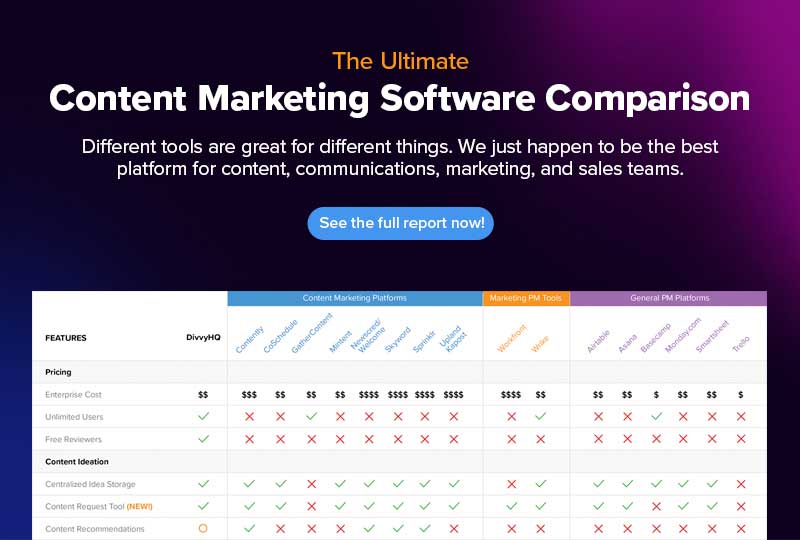DivvyHQ vs. Asana: Comparing Content Marketing Platforms
To execute content marketing with consistency and efficiency, content marketers rely on a variety of technology platforms. There are many options out there; some are purpose built just for content marketers, while others are general project management solutions. To understand which platform might be the best fit for your organization, we’ve done a big competitive analysis of all the platforms we run up against. But today, we’re focusing in on the comparison between DivvyHQ vs. Asana.
We’ll define how each solution stacks up in several categories, including:
- Pricing
- Content ideation features
- Content and editorial planning capabilities
- Workflow and collaboration offerings
- Content production and asset storage features
- Publishing functions and integrations
- Content and team performance analytics
- Service and support
- Setup and implementation requirements
- Security
- Other factors
Comparison Methodology
How did we complete the comparison of DivvyHQ vs. Asana? Our staff dug into various resources, including company websites, free trials, knowledge bases, review sites, and additional sources. The full report and methodology is available here: Content Marketing Platforms: DivvyHQ vs. the Alternatives.
In deciding what features to spotlight, we included the tools and features that content, marketing and communications teams need to do their job. Consider the criteria to be similar to those used by analyst firms Gartner and Forrester for the annual reports they publish on content marketing platforms (CMPs).
While we did our best to gather all available information, we certainly may have missed something. Not all platforms provide all details to the public.
If you’re a staff member of Asana, and you see something we got wrong, leave us a comment. We’ll fix it.
Now that we’ve defined the how, let’s get started.
Enterprise Pricing
First up is cost, which is, of course, a significant factor in choosing software. Asana is a general project management (PM) platform. Those in this category are usually lower-cost, but some exceptions apply.
Asana’s pricing structure is per user seat, which can become costly for enterprise teams. DivvyHQ also offers a per-seat option, but we have unlimited user plans for larger groups. Plus, there’s no cost for reviewers with read-only access to view campaigns and content projects in the works.
Content Ideation
Every piece of content starts out as an idea. Mature content teams typically have a way to intake, organize and manage them. DivvyHQ provides various tools to do this, centralizing ideation.
In this hub, you and your team can capture and nurture these ideas into projects. Another valuable component is the ability to use request intake forms to ask individuals outside of content marketing for content on a topic. Content recommendations are also an option.
Asana does have two of the three features DivvyHQ offers. It has a central idea storage element and users can submit request forms. It doesn’t allow for content recommendations.
Content and Editorial Planning Capabilities
The following features are the heart of a content marketing platform, and the most important one is the content calendar.
Both Asana and Divvy include dynamic content calendars. However, only DivvyHQ has a robust content calendar architecture that enables the creation of different calendars for individual business units, locations, brands, content channels, or other segments.
More planning features for both platforms include:
- Easy duplication of projects
- Multiple views (list, calendar, etc.)
- Color-coding
Calendar features for DivvyHQ only:
- Content strategy metadata management with filtering and reporting for the data (This helps users understand things like what segments you’re sending email campaigns to and if there’s an overload.
- Robust filtering
- Shareable views for non-users
Other essential functions that both platforms have are campaign planning and management and project/task prioritization.
One feature Asana has that DivvyHQ does not currently is resource management, which allows visibility into a team member’s workload.
Workflow and Collaboration Offerings
Technology plays an important role in content workflows and collaboration. With these components, you can eliminate manual work and streamline processes. In this category, the two applications provide very similar offerings, including:
- Task management
- Build custom workflows
- Automate workflow scheduling, notifications, and reminders
- Receive real-time browser notifications
- Comment with @mentions in content to tag users
Content Production and Asset Storage Features
The functionality in this section help content practitioners produce content and store assets natively within the application. DivvyHQ takes the lead here with more features. DivvyHQ delivers:
- An HTML content editor
- A social post editor
- Tracking changes and version history
- Storage for content and assets with no limitations
- Content archiving and auditing
- Asset library
Asana only has an asset library and storage for content, which they don’t limit.
Publishing Functions and Integrations
Integrations between platforms delivers efficiencies and makes everything easier. Without it, you may be stuck with manual work, which is a drain on time and productivity.
DivvyHQ Integrations
- WordPress
- Zapier
- Google Drive
- Dropbox
- Microsoft OneDrive
- SharePoint
- Box
- EpiServer
- Kentico
- Microsoft Outlook calendar
- Google calendar
- iCal
Asana integrates with all these platforms except for WordPress and EPiServer. Both systems have an open API.
Content and Team Performance Analytics
Content analytics are an essential part of the content marketing ecosystem. Centralizing all your data, however, can be a painful process. DivvyHQ aggregates data from over 100 sources to provide a holistic view.
The platform also lets you assess team performance with time tracking and reports for on-time completion and content strategy alignment.
Asana only has the time tracking feature, with no content analytics capabilities.
Service and Support
When your team adopts new software, you expect to have continued service and support. When customers deploy DivvyHQ, they receive live onboarding and a dedicated support team. We’ll also review your content strategy with recommendations and an analytics evaluation. Additionally, you’ll have online support chat whenever you need it.
Asana doesn’t seem to offer any sort of live onboarding or content marketing assessments, as the application isn’t content marketing specific. You will receive online chat support.
Setup and Implementation Ease
Setup and implementation can be barriers to adoption, but DivvyHQ and Asana are so easy, you can complete the process in less than four hours. You also won’t need any programmers to assist you.
Security
Understanding the security of an application is also a consideration. DivvyHQ and Asana each deliver robust user permissions and roles as well as SSO (single sign-on). DivvyHQ ups the security model with two-factor authentication.
Everything Else
This last section is for miscellaneous features that can be beneficial. DivvyHQ and Asana are both mobile-friendly. An implementation manager or full-time employee isn’t necessary to manage the platform.
DivvyHQ vs. Asana: What’s Right for You?
Looking at the comparison holistically, DivvyHQ has many content marketing features that Asana simply doesn’t have. This is because Asana is a multi-purpose solution. If you want software that delivers these content functions, you should try out DivvyHQ. You can do it for free today.


